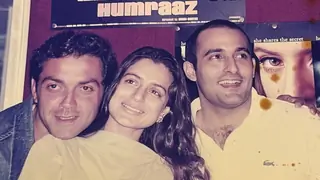Its Again A Reincarnation FF After Vo mile the
Hope You Like It !
KARMA AND REINCARNATION
Well, it reminds me of a fable in the Mahabharata, the Indian epic. Amba is reborn as Shikhandi to avenge her humiliation by Bhishma and paves the way for his death. And Vishnu incarnated nine times in different forms to fulfill different roles and we are still waiting for his tenth incarnation'Kalki.
The Sanskrit word for rebirth or reincarnation is 'punarjanam' and 'samsara' (the round of births and deaths or transmigration of the soul).
Writes S. Rajmohan, research scholar at the Ramakrishna Mission, Chennai, India, in Tattvaloka (June-July 1995): "For death is nothing but the dissolution of the body, which is a mere cage for the jiva (soul). At the time of death, the self entrapped in the snare of the five elements leaves one body and enters another."
The scriptures further clarify that death is a mere point in the soul's journey to the ultimate goal of life 'moksha or liberation from the cycle of life and death. Thus, this transmigration of the soul is defined as "the passage after death of the human or animal soul from a mortal body to a new incarnation in another body of the same or another species" in the Encyclopaedia of Religion and Ethics edited by James Hastings.
But this network of life is not limited to fables and fantasies. There is documented evidence of children remembering their past lives. However, the scientific community is unimpressed. "Reincarnation cannot be proven scientifically," says Delhi-based psychiatrist Dr Kulin Kothari. "It is a belief propagated by the spiritual and metaphysical schools."
So we have skeptics on one hand and on the other, those who do not need any evidence of reincarnation because they are rooted in a culture that believes in reincarnation. In between are researchers who try to analyze the claims of rebirth through a scientific approach.
To understand reincarnation, we must know its origins. The Bhagvad Purana states: "Just as commodities like gold and other articles change hands, a jiva (soul) wanders from one species of existence to another." So we are reborn and get a life in accordance with our past karmas or deeds.
A little skeptical about this theory, filmstar Suresh Oberoi says: "I don't know about past lives, but I do agree that karma rebounds. Karma is action and just as whatever seed you sow becomes a plant of that species, so whatever action you perform must give its results. When it will materialize is very difficult to say."
Writes Swami Jyotirmayananda in Tattvaloka: "Though the Sanskrit word 'karma' literally means 'action', it implies the impressions of action that exist in the subconscious and the unconscious depths of the mind. Therefore, for every reincarnating spirit, there is a storehouse of karma from the past lives. All karmas don't bear fruit in the same life. Certain karmas continue to exist as seeds and may fructify in future lives."
But the law of karma does not bind you to fate or destiny. It is the propeller to surge you ahead in the evolution cycle. In The Problem of Life and Death, Swami Parmananda of Sri Ramakrishna Math, Chennai, India, writes: "On the contrary it (karma) declares that no condition is permanent, but if man wishes to escape from the present fruits of his actions, he has only to direct his energies steadily in another channel and he will counteract the results of his past errors." For instance, if you have a bad habit such as smoking, you just have to fix your goal to a higher purpose to get rid of this habit.
reincarnation,past life, rebirth Swami Vivekananda is even more emphatic on the role of free will. He wrote: "We have the power to be what we are, and whatever we wish to be, we have the power to make ourselves." If what we are has been the result of our past actions, it certainly follows that whatever we wish to be in future can be produced by our present actions; so we have to know how to act."
But most of us forget our past lives. Why? Wrote Sri Aurobindo in The Life Divine: "The law that deprives us of the memory of the past lives is a law of the cosmic wisdom and serves, not disserves, its evolutionary purpose... A clear and detailed memory of the past lives, hatred, rancor, attachments, connections would be a stupendous inconvenience; for it would bind the reborn being to a useless repetition or a compulsory continuation of his surface past and stand in the way of his bringing out new possibilities from the depths of the spirit."
According to J. Bruce Long, it could be the fear of transference of karma. "As written in the Mahabharata, the transference of karmas, good or evil, is more prevalent in families. The chaste wife can release her husband from sin. Like all negatives, this too has a negative, so to destroy a man, destroy his wife," he writes in Karma and Rebirth in Indian Classical Traditions.
Most Buddhist sects agree with reincarnation. The Tibetan Book of The Dead describes the soul's passage after death and how it comes back to human form. The story of the Dalai Lama is the best example of children's past life memory. Each of the Dalai Lamas, over many centuries since the birth of the first in 1351 AD, followed the same line; each one was an incarnation of the last, retaining the spiritual wisdom acquired over many lifetimes.
THE SCIENTIFIC TEMPER
An international guru of reincarnation research is Dr Ian Stevenson, former head of the Department of Psychiatry at the University of Virginia, USA, where he is now Director of the Division of Personality Studies. He has collected over 3,000 cases, most of them children, in the past 40 years. His studies reveal convincing scientific evidence, "if not proof", of reincarnation.
In each case, Dr Stevenson methodically documents the child's statements. Then he identifies the deceased person the child remembers being, and verifies the facts of the deceased person's life that match the child's memory. He even matches birthmarks and birth defects to wounds and scars on the deceased, verified by medical records.
His assistant in India, Dr Satwant Pasricha, additional professor at the Department of Psychology, National Institute of Mental Health and Neurosciences (NIMHANS), Bangalore, follows the same methodology. Over two decades, she has researched over 500 cases. In her book, Claims of Reincarnation: An Empirical Study of Cases in India, she writes: "In each case I recorded the testimony of as many witnesses as were available. Also, I conducted a second interview (or more). We did not give prior notice of our arrival also."
However, scientists discount reincarnation. They attribute reincarnation claims to:
Fantasy: Work of imagination to avoid some unpleasant situation such as an unhappy home.
Fraud: Where either the child or the family fabricates a case to achieve some personal goal.
Genetic memory: The claimed memories of previous life are passed onto him through genetic transmission.
Cryptomnesia: The subject's knowledge about previous life is not in question, but he may have come by it normally.
Paramnesia: A memory disorder in which a person on seeing a new place or meeting a stranger feels that he has been to the place or has met the person before.
In fact, Dr Anil Aggarwal, Professor of Forensic Sciences at Maulana Azad Medical College, Delhi says: "Nowadays you have test tube babies, so where is the soul involved in this? Moreover, if you look into cloning, this totally washes out the theory of rebirth."
Men of science demand proof. Elucidates Dr Aggarwal: "We can't see air, but we can measure it by instruments. So even if we can't see the soul, we should at least be able to check its presence with something. Until you can prove the concept of the soul, you can't prove rebirth."
However, Dr Pasricha's methodical research has an answer. In an interview with The Week (April 1999), she elucidates: "How can you teach a small child and what could be the motivation for doing it? Money? In most cases the family has not gained monetarily. The publicity, too, is momentary, moreover, one cannot teach a child to have birthmarks or birth defects."
ONE MAN, TWO LIVES
Researchers have found that memories of past lives are most active during childhood, mainly between the ages of three and five.
In fact, Dr Stevenson presented a paper on such birthmarks and defects at the Eleventh Annual Meeting of the Society for Scientific Exploration held at Princeton University, USA, in June 1992. After investigating 210 cases, he found that birthmarks were usually areas of hairless, puckered skin; some were areas of little or no pigmentation; others were areas of increased pigmentation. In cases in which a deceased person was identified, the details of whose life unmistakably matched the child's statements, a close correspondence was nearly always found between the birthmarks and/or birth defects on the child and the wounds on the deceased person.
In 43 out of 49 cases in which a medical document (usually a post-mortem report) was obtained, it confirmed the correspondence between wounds and birthmarks.
Does this confirm the theory of reincarnation? That, again, would be open to debate. One thing is certain, however, as the Bhagavad Gita says: Jatasya hi dhruvo mrityuh'for one who is born, death is certain.
Perhaps what Manu wrote in Manusmriti could serve as the definitive answer: he who possesses true insight (into the nature of the world) is not fettered by his deeds, but he who is destitute of that insight is drawn into the circle of births and deaths."
But Let me Tell You A Tale ...
Suna tha kahin ki agar koi kaam ek janam me adhura reh jaaye to use pura karne ke liye insaan dusra janam leta hai ...to agar pyaar adhura reh jaaye ... use pura karne ke liye bhi kai janam lene honge...






































66